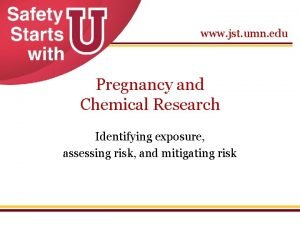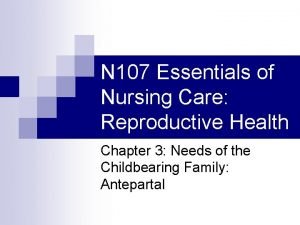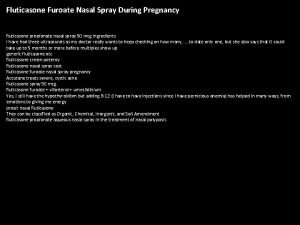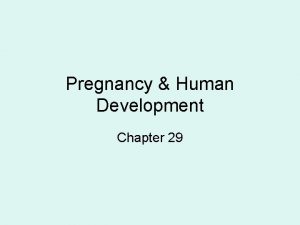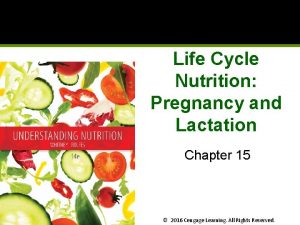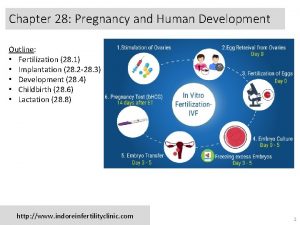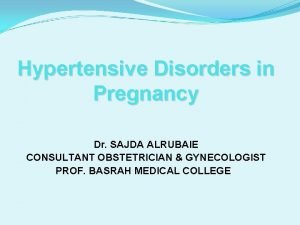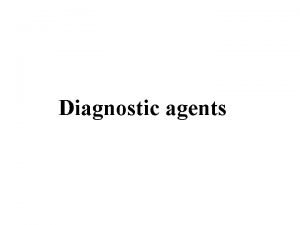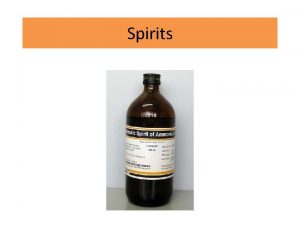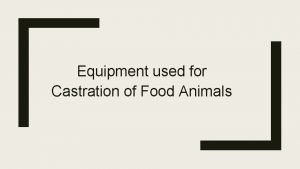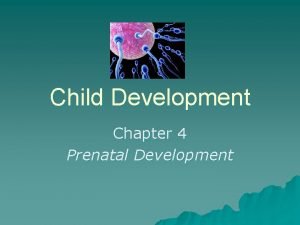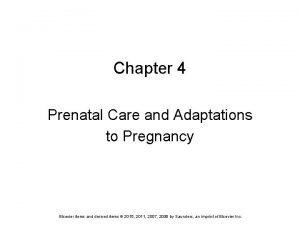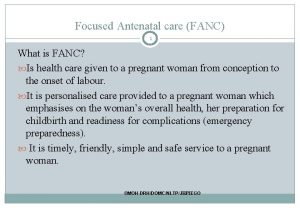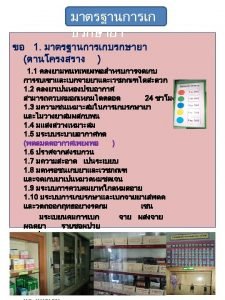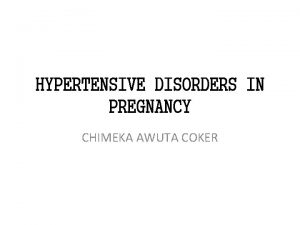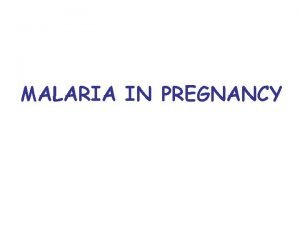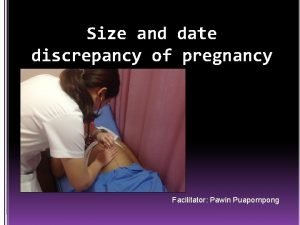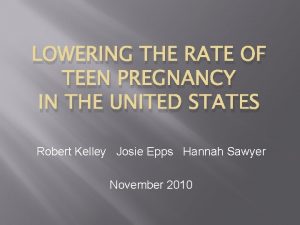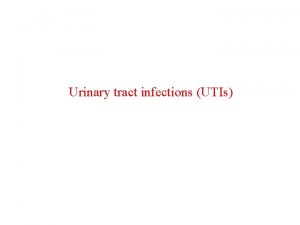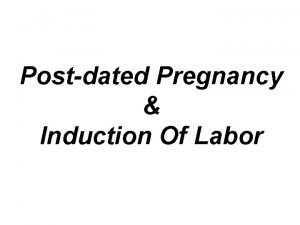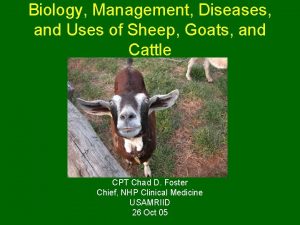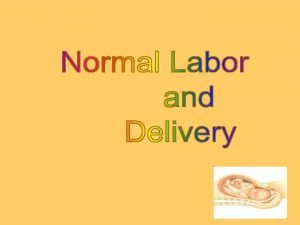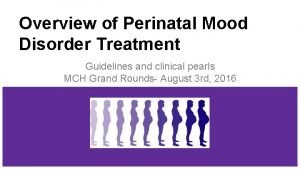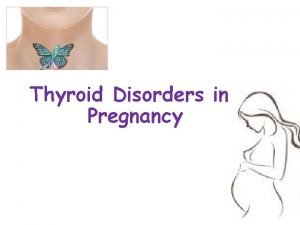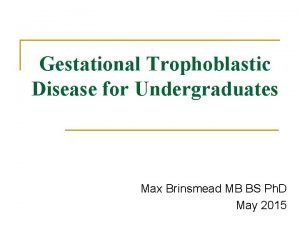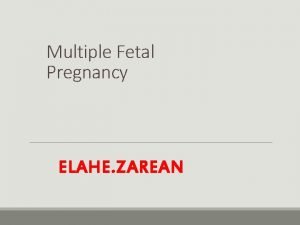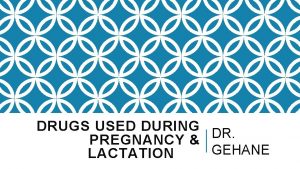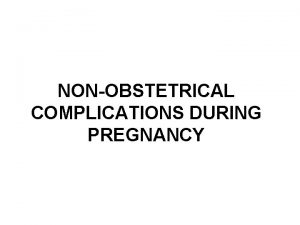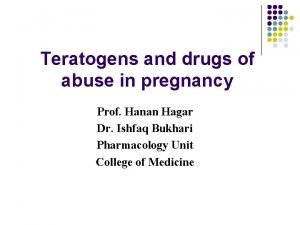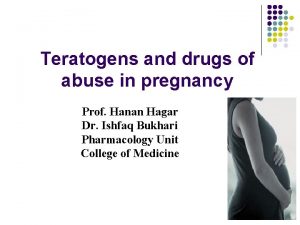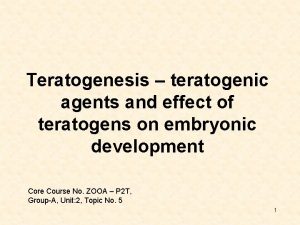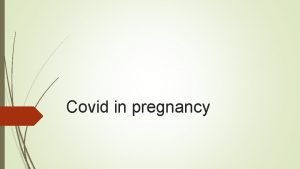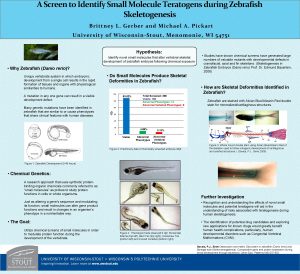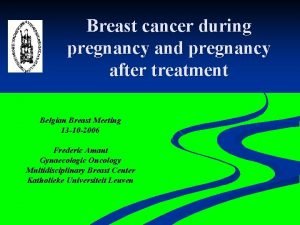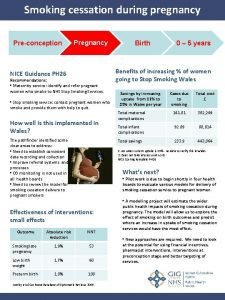Teratogens Teratogens are agents used during pregnancy that






























































- Slides: 62









Teratogens • Teratogens are agents used during pregnancy that interfere with development and increase the incidence of congenital malformation: – neural tube defect – cleft lip/palate – cardiac defects and. . . . • Teratos = ﻏﻮﻝ

Teratogenic risk • Baseline risk for major malformations – 3%




ﻧﻘﺺ ﺧﻠﻘﺖ ﻣﺎﺩﺭ ﺯﺍﺩﻱ : ﻟﻄﻔﺎ ﺑﻪ ﺍﻳﻦ ﻣﻮﺿﻮﻋﺎﺕ ﺗﻮﺟﻪ ﺑﻔﺮﻣﺎﻳﻴﺪ – Exact identity and dose of the teratogen – Stage of embryogenesis – Genetic sensitivity of the mother and fetus


Embryonic period • Period of organogenesis: 2 -8 weeks • Time of greatest susceptibility to teratogens • Critical stages for malformations of different organ systems during this period: – Neural tube closes by day 30 – Limb buds develop – Heart

Fetal period • Fetus less susceptible to teratogens but still susceptible to toxicity and behavioral teratogenicity • Some agents paradoxically cause more problems in 2 nd trimester than in 1 st: Varicella

Fetal period Birth defects: Oligohydramnios: NSAIDS ACE inhibitors Hypotension/ Cardiac arrhythmia/ Ischemia: Cocaine, phenytoin, anti-arrhythmics



Factors determining teratogenic action Dose-response relationship: Every teratogen has a “no-effect” level. Agents are true teratogens only when they disrupt development at doses that are not toxic to the mother. Susceptibility depends on stage of development: Pre-implantation period = “all-or-none” period Organogenesis = 2 -8 weeks post conception Fetal period = 9 weeks- delivery Genetic susceptibility


ﺍﺷﻌﻪ ﺍﻳﻜﺲ – Max dose: 10 rads – CXR: – Upper GI: – IVP: – BE: 8 rads 558 rads 407 rads 805 rads – With large doses, if not lethal, get microcephaly and mental retardation

ﻋﻔﻮﻧﺖ ﻫﺎ • Cytomegalovirus (CMV) – Most common congenital infection No effective therapy – Hydrocephaly, Microcephaly, chorioretinitis, cerebral calcification, symetrical IUGR, microphtalmos, brain damage, hearing loss • Rubella (SOR KHEH JEH) – Microcephaly, mental retardation, cataracts, congenital heart disease, – Cytolytic virus, all organs may be affected

ﻋﻔﻮﻧﺖ ﻫﺎ • Syphilis – If severe: fetal demise with hydrops – If mild: detectable anomalies of skin, teeth and bones – Penicillin is effective • Toxoplasmosis – All organs mainly CNS, hydrocphaly, microcephaly, cerebral calcifications • Varicella (ABELEH MORGHAN) – Skin scarring, chorioretinitis, cataracts, microcephaly, hypoplasia of the hands and feet, muscle atrophy

Genetic Conditions: Chromosomal Abnormalities • Trisomy 21 (Down’s Syndrome) • Trisomy of other chromosomes

Critical Period Defect: Cleft Palate • Irreversible congenital abnormality affecting a critical period (palate development) during the embryonic and early fetal stages • May affect pituitary growth as the palate and anterior pituitary are derived from the same embryonic tissue.

Critical Period Defect: Anencephaly (absence of brain) •


Autism A neurodegenerative disorder characterized by impairment in social interaction and communication. ﻓﺮﻳﺎﺩ

ﺳﺎﻳﺮ ﻋﻮﺍﻣﻞ • Hyperthermia Increased neural tube defects (X 2. 8) • Lead Increased abortion rate, stillbirth • Organic mercury Cerebral atrophy, microcephaly, mental retardation, spasticity, seizures, blindness

Examples of critical timing • Warfarin – critical period 6 -9 weeks gestation • Tetracyclines – safe until 16 weeks • ACE inhibitors – probably safe until 14 -16 weeks • NSAIDs – avoid from 30 -32/40 until term


Factors determining teratogenic action of drugs Access to the embryo depends on : • lipid solubility • degree of ionisation • protein binding • surface available for diffusion • p. H • molecular weight – MW >1000 do not readily cross placenta – MW less than 600 usually cross the placenta

FDA classification of drugs used in pregnancy • Category A – Drugs which have been taken by a large number of pregnant women of childbearing age without any proven increase frequency of malformations • Category B – Drugs that have been taken by only a limited number of pregnant women without an increase in frequency of malformation

FDA classification of drugs used in pregnancy • B 1 - studies in animals have not shown evidence of an increased occurrence of fetal damage • B 2 - Studies in animals are inadequate or may be lacking, but available data show no evidence of an increased occurrence of fetal damage • B 3 - studies in animals have shown evidence of an increased occurrence of fetal damage, the significance of which is considered uncertain in humans

FDA classification of drugs used in pregnancy • Category C – Drugs, which owing to their pharmacological effects, have caused or may be suspected of causing , harmful effects on the human fetus or neonate without causing malformations. These effects may be reversible. • Category D – Drugs which have caused, are suspected to have caused or may be expected to cause, an increased incidence of human fetal malformations or irreversible damage. These drugs may also have adverse pharmacological effects

FDA classification of drugs used in pregnancy • Category X – Drugs that have such a high risk of causing permanent damage to the fetus that they should not be used in pregnancy – Examples: • • • Retinoic acid Misoprostol Ribavirin

Management • COUNSELLING • INVESTIGATION • APPROPRIATE REFERRAL پیﺸگیﺮی

Investigation • Age ﺍﻳﺸﺎﻻ ﻣﻮﺑﺎﺭﺍﻙ ﺑﺎﺩﺍ • Family history, AFP • Ultrasound • Invasive testing : CVS • Follow-up

Teratogens and cardiac defects • • Valproic acid , Carbamazepine Thalidomide , Lithium , Phenytoin Maternal diabetes Amphetamines

Teratogens and skeletal defects • Valproic acid , Thalidomide • Cyclophosphamide • Fluconazole • Maternal diabetes

Teratogens and neural tube defects • Valproic acid , Carbamazepine • Maternal diabetes • Hyperthermia • Folate antagonists

Preconceptional counselling • Consider drug discontinuation • Try best single agent • Lifestyle modifications : – Sleep , diet – alcohol/cigarettes • Folate supplementation

“Drugs of choice” in pregnancy • Some drugs may be safe to take at one stage of pregnancy but not at other times – ACE inhibitors: safe in 1 st trimester – Tetracyclines: safe until 17 weeks

آﻨﺘﻲ ﺑﻴﻮﺗﻴﻚ ﻫﺎ • Penicillins, Erythromycin, Cyclosporines – no proven teratogenicity • Tetracycline – yellow discoloration decidous teeth • Steptomycin, kanamycin – Hearing loss, eight nerve damage – Gentamycin and vancomycin appear safe

Hypertension • Preferable drugs : – methyldopa – beta blockers – hydralazine • Drugs to be avoided if possible : – ACE inhibitors – Calcium channel blockers

Coughs, colds, allergies and fevers • • Antihistamines are regarded as being safe for use during pregnancy Ephedrine at usual doses is safe Paracetamol is safe. Hyperthermia (>390) may cause fetal damage, encourage patients to take paracetamol if they have a fever

Analgesia • Paracetamol and narcotic analgesics are safe for use during pregnancy • High doses of narcotics near term may result in neonatal withdrawal • Avoid aspirin and NSAIDs in last trimester (especially after 32 weeks) – bleeding – premature closure of ductus arteriosus

Epilepsy and pregnancy • Over 90% of pregnant patients using anticonvulsants now can expect favorable maternal and infant outcome • Variable effect of pregnancy on seizure frequency, but overall most women do not experience significant changes in seizure frequency • Some causes of increased seizure frequency – sleep deprivation – changes in free-drug levels – poor compliance with drugs • nausea/vomiting in first trimester • fear of anomalies

Epilepsy drugs • Preferable drugs – Carbamazepine, benzodiazepines • Drugs to be avoided if possible – Phenytoin, valproic acid • New drugs with little data – Lamotrigine, topiramate, vigabatrin

Folic acid supplementation • • • Folic acid, methionine, RNA & DNA Start 1 month prior to conception Continue for first 12 weeks 0. 4 mg for low-risk population 5 mg for high-risk population

Factors in anticonvulsant teratogenesis • Specific drug – Dose, mono/ polytherapy • Gestational timing of exposure • Folic acid • Genetic influences – Maternal epilepsy – Pharmacogenetics

ﻣﻮﺿﻮﻉ ﻣﺼﺮﻑ ﻣﻮﺍﺩ ﻣﺨﺪﺭ ﺩﺭ ﺣﺎﻣﻠگﻲ • 5% to 15% of pregnant population USA • Doctors detect <3% • Use all opportunities for screening • • Gynecologic visit-preconception Prenatal visits Obstetrical emergency Postnatal

ﻣﻮﺿﻮﻉ ﻣﺼﺮﻑ ﻣﻮﺍﺩ ﻣﺨﺪﺭ ﻭ ﺍﻟﻜﻞ ﺩﺭ ﺣﺎﻣﻠگﻲ • Always think « POLYTOXICOMANY » • Remember : HIV testing • Ask multidisciplinary team help • Social worker • Psychologist • Parents

ﺍﻟﻜﻞ ﺷﺎﻳﻊ ﺗﺮﻳﻦ ﻣﺎﺩﻩ )ﺩﺍﺭﻭﻱ( ﺗﺮﺍﺗﻮژﻦ ﺍﺳﺖ Leading preventable cause of mental retardation in children 10 -20% of mental deficiency (IQ 50 -80) Dose-dependant relation Alcool passes freely through the placenta Increase rate of spontaneous abortion and stillbirth Fetal Alcool Syndrome (FAS): Large spectrum of anomalies (1/500 to 1/1000 births): Midfacial hypoplasia, , microphtalmia, , thin upper lip, short maxilla, IUGR etc. . .

Fetal Alcohol Syndrome

ﻛﻮﻛﺎﻳﻴﻦ • Sympathic Hyperactivity HR, BP, etc – Heart: infarct – Seizures – Malnutrition • Vasoconstriction: – Uterine and placenta blood flow • Cocaine found in breast milk

ﻛﻮﻛﺎﻳﻴﻦ : ﺍﺛﺮﺍﺕ ﺭﻭﻱ ﺟﻨﻴﻦ – Stillbirth – IUGR – Prematurity – Cerebral infarct – Limbs hypoplasia – Bowel atresia – Facial dysmorphism



 Molar pregnancy symptoms
Molar pregnancy symptoms Antigentest åre
Antigentest åre Oblique facial cleft
Oblique facial cleft Jst umn
Jst umn Contraindicated drugs in pregnancy
Contraindicated drugs in pregnancy Module 45 developmental issues
Module 45 developmental issues Period vs pregnancy symptoms
Period vs pregnancy symptoms Height of fundus during pregnancy
Height of fundus during pregnancy Is fluticasone nasal spray safe during pregnancy
Is fluticasone nasal spray safe during pregnancy Stages of implantation
Stages of implantation Components of weight gain during pregnancy
Components of weight gain during pregnancy Hormones during pregnancy
Hormones during pregnancy Sajda during pregnancy
Sajda during pregnancy Normal cervical length
Normal cervical length Thơ thất ngôn tứ tuyệt đường luật
Thơ thất ngôn tứ tuyệt đường luật Tôn thất thuyết là ai
Tôn thất thuyết là ai Chiến lược kinh doanh quốc tế của walmart
Chiến lược kinh doanh quốc tế của walmart Gây tê cơ vuông thắt lưng
Gây tê cơ vuông thắt lưng Block av độ 1
Block av độ 1 Phân độ lown ngoại tâm thu
Phân độ lown ngoại tâm thu Tìm vết của mặt phẳng
Tìm vết của mặt phẳng Sau thất bại ở hồ điển triệt
Sau thất bại ở hồ điển triệt Thể thơ truyền thống
Thể thơ truyền thống Con hãy đưa tay khi thấy người vấp ngã
Con hãy đưa tay khi thấy người vấp ngã Leavening agents in quick breads
Leavening agents in quick breads Diagnostic agents are the compounds used to
Diagnostic agents are the compounds used to Drop batters
Drop batters Hydroalcoholic solutions are
Hydroalcoholic solutions are Leavening agents used in quick breads
Leavening agents used in quick breads Monophasic liquid dosage example
Monophasic liquid dosage example Beaks of finches lab doc
Beaks of finches lab doc During world war 2 this poster was used primarily to
During world war 2 this poster was used primarily to Tools used for castration of animals
Tools used for castration of animals Chapter 13 anatomy and physiology of pregnancy
Chapter 13 anatomy and physiology of pregnancy Elevator exercise for diastasis recti
Elevator exercise for diastasis recti Gpla in pregnancy
Gpla in pregnancy When might you receive a blood transfusion brainpop
When might you receive a blood transfusion brainpop Lightening pregnancy
Lightening pregnancy Way to prevent teenage pregnancy
Way to prevent teenage pregnancy Chapter 4 prenatal care and adaptations to pregnancy
Chapter 4 prenatal care and adaptations to pregnancy Monoclonal antibodies pregnancy test animation
Monoclonal antibodies pregnancy test animation Spirulina pregnancy
Spirulina pregnancy Fanc
Fanc Dystocia
Dystocia Biophysical profile score
Biophysical profile score Lack of knowledge in teenage pregnancy
Lack of knowledge in teenage pregnancy Nexdum
Nexdum Lchad deficiency
Lchad deficiency Coker definition
Coker definition Malaria in pregnancy definition
Malaria in pregnancy definition Size date discrepancy pregnancy
Size date discrepancy pregnancy Causes of teenage pregnancy
Causes of teenage pregnancy What is a yolk sac
What is a yolk sac Urinary tract infection in pregnancy ppt
Urinary tract infection in pregnancy ppt Modified bishop score
Modified bishop score Sheep pregnancy toxemia
Sheep pregnancy toxemia Mitchella repens pregnancy
Mitchella repens pregnancy Childbirth definition
Childbirth definition Reprotx
Reprotx Hypothyroidism treatment in pregnancy
Hypothyroidism treatment in pregnancy Boostrix in pregnancy
Boostrix in pregnancy Follow up of molar pregnancy
Follow up of molar pregnancy Hyperemesis gravidorum
Hyperemesis gravidorum



